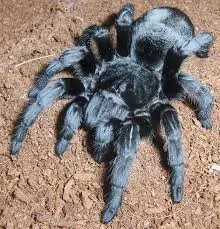Aging in Grammostola pulchra: Physical Decline and End-of-Life Care in Captivity
Introduction: A Long Life in Captivity
*Grammostola pulchra* is known for its longevity, especially females, which can potentially live for 20-30 years or even longer in optimal captive conditions. Males have significantly shorter lifespans, typically maturing within a few years and living only 1-2 years post-maturity. As these tarantulas reach advanced ages, keepers may observe signs of physical decline, similar to aging processes in other animals.
Signs of Aging in G. pulchra
While tarantulas don’t “go grey,” subtle changes can indicate senescence (aging):
- Slower Movement: Reduced speed and agility, spending more time stationary.
- Decreased Appetite: Eating less frequently or consuming smaller prey items.
- Longer Molting Cycles: The time between molts may increase significantly in very old individuals.
- Difficulty Molting (Dysm Ecolysis): Older tarantulas may have a harder time successfully shedding their exoskeleton, increasing the risk of complications like losing limbs or death during the molt. This is one of the primary risks for geriatric tarantulas.
- Less Active Behaviors: Reduced interest in rearranging substrate, climbing, or exploring the enclosure.
- Appearance Changes: While not drastic, some very old tarantulas might appear slightly less vibrant, or exhibit minor wear and tear on spinnerets or leg tips (though this can also be due to enclosure friction).

Potential Age-Related Health Issues
Beyond molting difficulties, older tarantulas might be more susceptible to:
- Weakened Immune System: Potentially slower recovery from injuries or infections.
- Reduced Mobility: Making it harder to hunt or access water if not easily reachable.
- Organ Function Decline: Although difficult to assess externally, internal organ function likely declines with extreme age.
Providing attentive geriatric tarantula care focuses on minimizing stress and ensuring easy access to resources.
End-of-Life Care Considerations
When a *G. pulchra* enters its final stages, the focus shifts to palliative care:
- Ensure Easy Access: Keep the water dish shallow, full, and very close to the tarantula’s usual resting spot.
- Offer Easy Prey: Offer smaller, pre-killed, or slow-moving prey items directly near the tarantula if it still shows interest in food. Remove uneaten food promptly.
- Maintain Stability: Avoid unnecessary changes to the enclosure environment (temperature, humidity, layout). Minimize handling and disturbances.
- Monitor Closely: Check on the tarantula daily for changes in condition or signs of distress.
- Humane Euthanasia (Veterinary Option): If the tarantula is clearly suffering with no hope of recovery (e.g., severely stuck molt, debilitating injury), consultation with an experienced exotics veterinarian regarding humane euthanasia might be considered. This is a difficult decision reserved for cases of irreversible suffering.
Natural Decline: Often, very old tarantulas simply slow down gradually, stop eating, and eventually pass away peacefully. The goal of end-of-life care is to make this process as stress-free as possible.
The Importance of Consistent Husbandry
Providing excellent, consistent husbandry throughout a tarantula’s life is the best way to support its longevity and health into old age. Stable temperatures, appropriate humidity, a secure environment, and a suitable diet minimize stress and allow the tarantula to reach its full potential lifespan. Observing the subtle signs of aging helps keepers adjust care as needed for their veteran pets.
Further Reading: General concepts of aging in biology are discussed under Senescence on Wikipedia.